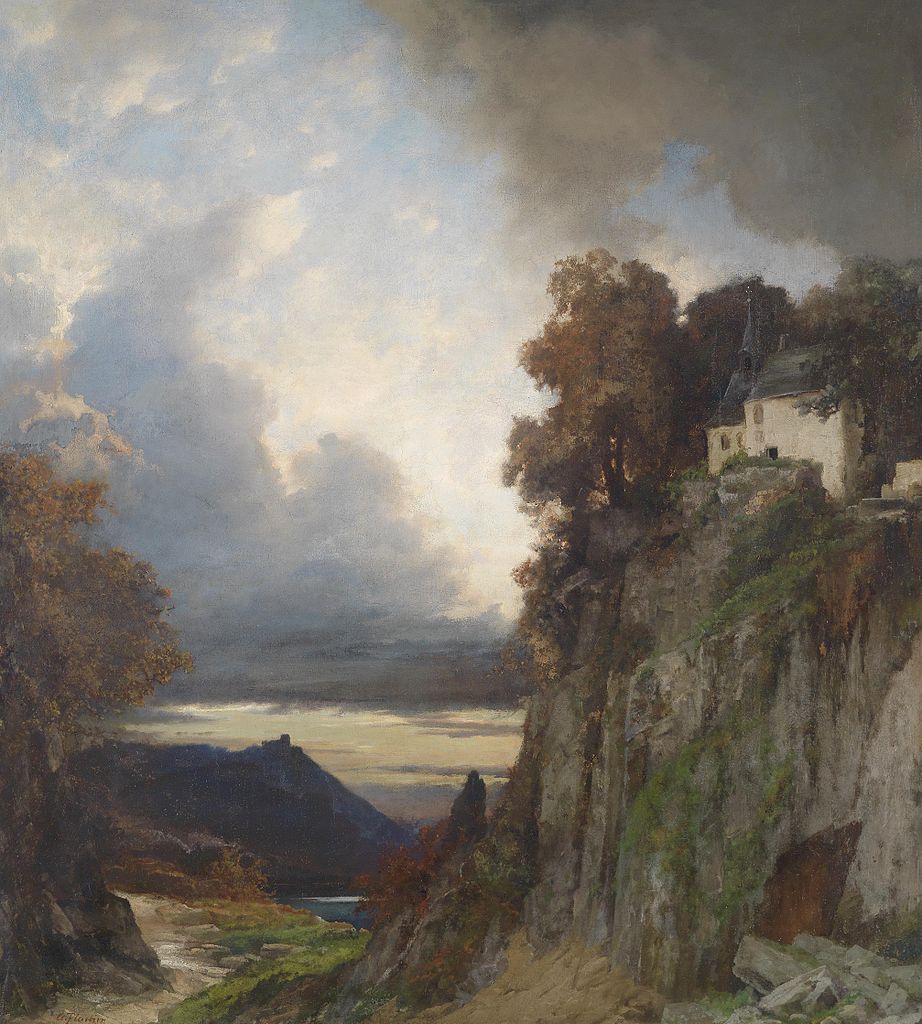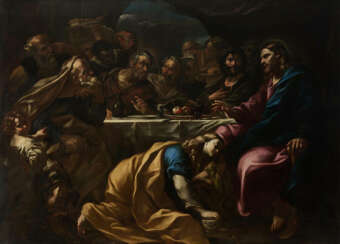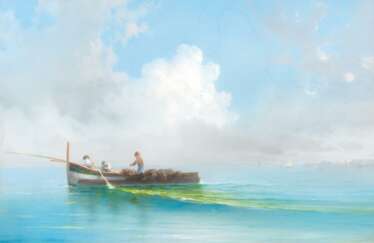near naples

Albert Flamm was a German artist of the Düsseldorf school. He studied architecture at the Dusseldorf Academy of Art and in Antwerp. In 1841 he turned to painting and became a pupil of Andreas Achenbach. In 1848 Flamm became one of the founders of the Malkasten artists' association.
Albert Flamm painted mainly Italian landscapes, recognised for their truthfulness of nature, their vivid colours and their virtuosic treatments. He often chose an elevated viewing position to be able to create wide panoramic perspectives in warm, bright sunlight and with finely rendered detail.


Giovanni Battista Beinaschi, an Italian painter and fresco artist of the Baroque era, was born in 1636 and left an indelible mark on the art world before his death in 1688. Renowned for his dynamic compositions and vibrant use of color, Beinaschi's work epitomizes the grandeur and emotive power of Baroque art, reflecting the period's cultural and artistic aspirations.
Beinaschi's contributions to art are notable for their intricate details, dramatic use of light and shadow, and the emotional intensity of the figures portrayed. His mastery in fresco and oil painting allowed him to create expansive religious narratives and intimate portraits alike, each brimming with life and depth.
Among his celebrated works, those housed in esteemed museums and galleries across Europe serve as testaments to his skill and creativity. Beinaschi's frescoes, in particular, are admired for their architectural harmony and the seamless integration of figures into their surroundings, showcasing his innovative approach to spatial composition.
For collectors and experts in art and antiques, Giovanni Battista Beinaschi's paintings are more than just visual delights; they are windows into the soul of the Baroque period. His ability to convey complex emotions and spiritual themes through art makes his works highly sought after and revered in the history of painting.
If you wish to delve deeper into the world of Baroque art and explore the genius of Giovanni Battista Beinaschi, consider signing up for updates. This subscription will keep you informed about new discoveries, sales, and auction events related to Beinaschi's works, ensuring you never miss an opportunity to appreciate or acquire pieces by this exceptional artist.


Corrado Giaquinto was a prominent Italian painter of the Rococo period. His journey into the arts took him from apprenticeships with local painters in his youth to a flourishing career across Italy and Spain. Giaquinto's early training under Saverio Porta and subsequent studies in Naples under Nicola Maria Rossi and Francesco Solimena honed his skills in the Neapolitan painting tradition. By the time he moved to Rome in 1727, his style had matured, leading to collaborations on significant projects and solo commissions that showcased his mastery of the Rococo style.
Giaquinto's work is known for its vibrant colors, dynamic compositions, and the integration of classical and religious themes, reflective of the Rococo spirit. His frescoes and oil paintings, such as "The Penitent Magdalen" and "Medea Rejuvenating Aeson," are celebrated for their technical brilliance and emotional depth, housed in prestigious museums like the Metropolitan Museum of Art in New York and the Louvre Museum in Paris. His significant contribution to the art world extends to his role as a court painter in Madrid, where he influenced the Spanish art scene profoundly during his tenure from 1753 to 1761.
For collectors and experts in art and antiques, Giaquinto's oeuvre offers a fascinating glimpse into the opulence and elegance of 18th-century Rococo art. His ability to blend dramatic narratives with delicate details makes his work a study in the balance between grandeur and grace, marking him as a key figure in the transition from the Baroque to Rococo styles.
To explore more about Corrado Giaquinto's influential work and to stay informed about exhibitions or sales featuring his art, signing up for updates from art institutions can provide exclusive insights into the world of this illustrious Rococo painter. This subscription is tailored for enthusiasts keen on delving deeper into the rich tapestry of 18th-century European art, ensuring they remain abreast of relevant developments and opportunities related to Giaquinto's legacy.


Iacopo Negretti, best known as Jacopo or Giacomo Palma il Giovane or simply Palma Giovane ("Young Palma"), was an Italian painter from Venice and a notable exponent of the Venetian school. After Tintoretto's death (1594), Palma became Venice's dominant artist perpetuating his style. Outside Venice, he received numerous commissions in the area of Bergamo, then part of the Venetian Domini di Terraferma, and in Central Europe, most prominently from the connoisseur emperor Rudolph II in Prague. Rejecting Mannerism in the 1580s, he embraced a reformist naturalism.[6] He varied the ingeniously synthesised amalgam according to subject matter and patrons' own eclectic and conservative tastes, with "virtuoso skill and a facile intelligence". Palma il Giovane went on to organize his own, large studio which he used to produce a repetitive series of religious and allegorical pictures that can be found throughout the territory of the Venetian Republic.


Jakob Philipp Hackert was a German painter of the second half of the 18th and early 19th centuries. He is known as a landscape painter and printmaker, a representative of neoclassicism and romanticism.
Hackert reached the peak of creative activity in 1770-1780. He was recognized by the European aristocracy, and for a time served as court painter to King Ferdinand IV of Naples, as well as receiving commissions from representatives of the Russian imperial family, such as Empress Catherine II and the heir to the throne, Paul Petrovich. His work, according to critics, was characterized by high craftsmanship and aristocratic elegance.


Oswald Achenbach was a German painter associated with the Düsseldorf school of painting. Though little known today, during his lifetime he was counted among the most important landscape painters of Europe. Through his teaching activities, he influenced the Kunstakademie Düsseldorf. His brother, Andreas Achenbach, who was twelve years older, was also among the most important German landscape painters of the 19th century. The two brothers were humorously called "the A and O of Landscapes" (a reference to their initials matching a common German reference to the Alpha and Omega).


Samuel Palmer was a 19th-century English painter. He is known as a representative of Romanticism. Samuel Palmer was a master of the landscape genre, and most of his paintings were in watercolor.
Samuel Palmer, though not academically trained, was also a good illustrator and printmaker. He had serious financial problems all his life, causing him to combine a professional career as an artist with a job as an art teacher for nearly 20 years. Only towards the end of his life was Palmer able to devote himself fully to art.
The best masterpieces of the artist's work today are kept in British museums.


Samuel Palmer was a 19th-century English painter. He is known as a representative of Romanticism. Samuel Palmer was a master of the landscape genre, and most of his paintings were in watercolor.
Samuel Palmer, though not academically trained, was also a good illustrator and printmaker. He had serious financial problems all his life, causing him to combine a professional career as an artist with a job as an art teacher for nearly 20 years. Only towards the end of his life was Palmer able to devote himself fully to art.
The best masterpieces of the artist's work today are kept in British museums.




Francesco Solimena was an Italian painter of the seventeenth and eighteenth centuries. He is known as a representative of the Neapolitan school of late Baroque painting. The painter's creativity was highly appreciated by his contemporaries, during his long career he earned a large fortune by selling his works. The artist's biography is closely linked to Naples, the city in which the great genius spent most of his life.
Francesco Solimena was devoted to the religious genre, for which he was often called "Abbot Ciccio" during his lifetime. He educated many famous artists. Solimena's paintings are now in museums in St. Petersburg (Hermitage), London (National Gallery), New York (Metropolitan Museum of Art), Paris (Louvre) and other cities.


Francesco Solimena was an Italian painter of the seventeenth and eighteenth centuries. He is known as a representative of the Neapolitan school of late Baroque painting. The painter's creativity was highly appreciated by his contemporaries, during his long career he earned a large fortune by selling his works. The artist's biography is closely linked to Naples, the city in which the great genius spent most of his life.
Francesco Solimena was devoted to the religious genre, for which he was often called "Abbot Ciccio" during his lifetime. He educated many famous artists. Solimena's paintings are now in museums in St. Petersburg (Hermitage), London (National Gallery), New York (Metropolitan Museum of Art), Paris (Louvre) and other cities.


Francesco Solimena was an Italian painter of the seventeenth and eighteenth centuries. He is known as a representative of the Neapolitan school of late Baroque painting. The painter's creativity was highly appreciated by his contemporaries, during his long career he earned a large fortune by selling his works. The artist's biography is closely linked to Naples, the city in which the great genius spent most of his life.
Francesco Solimena was devoted to the religious genre, for which he was often called "Abbot Ciccio" during his lifetime. He educated many famous artists. Solimena's paintings are now in museums in St. Petersburg (Hermitage), London (National Gallery), New York (Metropolitan Museum of Art), Paris (Louvre) and other cities.


Oswald Achenbach was a German painter associated with the Düsseldorf school of painting. Though little known today, during his lifetime he was counted among the most important landscape painters of Europe. Through his teaching activities, he influenced the Kunstakademie Düsseldorf. His brother, Andreas Achenbach, who was twelve years older, was also among the most important German landscape painters of the 19th century. The two brothers were humorously called "the A and O of Landscapes" (a reference to their initials matching a common German reference to the Alpha and Omega).


Albert Flamm was a German artist of the Düsseldorf school. He studied architecture at the Dusseldorf Academy of Art and in Antwerp. In 1841 he turned to painting and became a pupil of Andreas Achenbach. In 1848 Flamm became one of the founders of the Malkasten artists' association.
Albert Flamm painted mainly Italian landscapes, recognised for their truthfulness of nature, their vivid colours and their virtuosic treatments. He often chose an elevated viewing position to be able to create wide panoramic perspectives in warm, bright sunlight and with finely rendered detail.


Jean-Édouard Vuillard was a French artist, celebrated for his role in the avant-garde group Les Nabis. Known for his decorative art and printmaking, Vuillard's work was heavily influenced by Japanese prints, which is evident in his unique style of flattened color planes and simplified forms. His paintings, often of interior scenes, are distinguished by their intimate and domestic subjects, displaying a keen sensitivity to the subtle dynamics of everyday life.
In the late 1880s, Vuillard joined Les Nabis, a group of artists who sought to break away from traditional artistic concepts. This association played a pivotal role in shaping his artistic philosophy. Vuillard’s early works, like "The Seamstresses" (1890) and "Child in an Orange Shawl" (1894–95), demonstrate his evolving style, marked by the use of vibrant colors and a distinct lack of perspective, aimed at exploring spatial relationships.
Vuillard's artistic journey included ventures into theater decoration and interior design. He designed stage sets and theater programs, notably for Lugné-Poe's Theatre de l’Oeuvre, and also worked on large-scale panel paintings for French patrons. His close collaboration with the Natanson brothers, founders of the cultural review La Revue Blanche, was significant in his career. This association brought him various commissions, including decorative works for private homes and public buildings.
Vuillard's art evolved over time, transitioning from his Nabis-style works to more naturalistic portraits in the 1920s and 1930s. Despite this shift, his focus remained on portraying the intricacies of domestic life, often featuring the people closest to him. Notable among his subjects were Misia Natanson, a prominent figure in the Parisian cultural scene, and Lucy Hessel, with whom Vuillard had a long-term relationship.
For art collectors and experts, Vuillard's works are a window into the intimate spaces of Parisian life at the turn of the century. His ability to transform everyday scenes into art makes his work particularly appealing. Pieces like "The Green Interior" (1891) and "Breakfast at Villerville" (1910) are exemplary of his style and are celebrated for their quiet yet profound depiction of ordinary life.
Vuillard's legacy lives on in galleries and museums worldwide. His work remains a testament to the power of domestic scenes in art, capturing the essence of the period with a unique blend of realism and abstraction.
For those interested in the subtle beauty of Vuillard's work, subscribing to our updates will ensure you stay informed about new sales and auction events featuring his art. Our updates are tailored for connoisseurs like you, providing insights into the world of art and antiques, with a focus on Vuillard's enduring legacy.


Artemisia Gentileschi was a pioneering Italian painter of the Baroque era, celebrated for her vivid portrayals of dramatic scenes and strong female figures drawn from mythology, allegory, and the Bible. Born in Rome in 1593, Gentileschi broke through the gender barriers of her time to become one of the first women to achieve fame as an artist. Her early exposure to painting came through her father, Orazio Gentileschi, a follower of Caravaggio, whose influence is evident in Artemisia's use of chiaroscuro and realistic, emotional expression.
Gentileschi's artistry is particularly noted for its naturalism and the dynamic use of color, which she employed to convey depth and drama. Among her most renowned works are "Susanna and the Elders" (1610), showcasing her skill in portraying the vulnerability and dignity of its subject, and "Judith Slaying Holofernes" (c. 1614–1620), a vivid depiction of strength and determination, housed in the Uffizi Gallery. These works, along with others like "Judith and Her Maidservant" (1625) in the Detroit Institute of Arts, highlight her unique ability to present female subjects not just as objects of beauty, but as agents of power and action.
The complexity of Gentileschi's life, including her survival of rape by Agostino Tassi and the subsequent trial, has often overshadowed her artistic achievements. However, modern scholarship and exhibitions, such as those at the National Gallery in London, have reevaluated her contributions, positioning her as a significant figure in art history for both her mastery of Baroque painting techniques and her role in challenging the era's gender norms.
For art collectors and experts, Gentileschi's works are emblematic of the Baroque spirit and a testament to the resilience and talent of women artists in a male-dominated field. Her paintings are not only valuable for their aesthetic and historical significance but also for their inspirational narrative of overcoming personal and societal challenges.
To stay updated on new product sales and auction events related to Artemisia Gentileschi, signing up for updates is recommended. This subscription ensures you remain informed about opportunities to acquire pieces related to this groundbreaking artist, without any pomp or unnecessary fluff, focusing purely on her incredible legacy in the realms of culture, art, and painting.


William Hamilton was an English artist and illustrator.






























































![William Hamilton | Campi phlegraei. Paris, [1799-1802], a deluxe copy with plates in two states](/assets/image/picture_3552953/71e1c/swqxwjtgq1ugvnwqi2apzgfoiilhqdrokd3a-bot1khfha9pyeckuouug-95a3ll1699088974jpg__fix_374_244.jpeg)
![William Hamilton | Campi phlegraei. Paris, [1799-1802], a deluxe copy with plates in two states](https://veryimportantlot.com/assets/image/picture_3552953/71e1c/swqxwjtgq1ugvnwqi2apzgfoiilhqdrokd3a-bot1khfha9pyeckuouug-95a3ll1699088974jpg__fix_374_244.jpeg)





![FIBONACCI, Leonardo [c.1170-c.1250]; BOETHIUS, Anicius Manlius Severinus [c.480-524], GROSSETESTE, Robert [1175-1253]; [DE PULCHRO RIVO, Johannes, attrib.]](/assets/image/picture_2279440/69ac3/5672d49f6fe2176fe5b0465502ca1a9b1657663200jpg__fix_374_244.jpeg)
![FIBONACCI, Leonardo [c.1170-c.1250]; BOETHIUS, Anicius Manlius Severinus [c.480-524], GROSSETESTE, Robert [1175-1253]; [DE PULCHRO RIVO, Johannes, attrib.]](https://veryimportantlot.com/assets/image/picture_2279440/69ac3/5672d49f6fe2176fe5b0465502ca1a9b1657663200jpg__fix_374_244.jpeg)